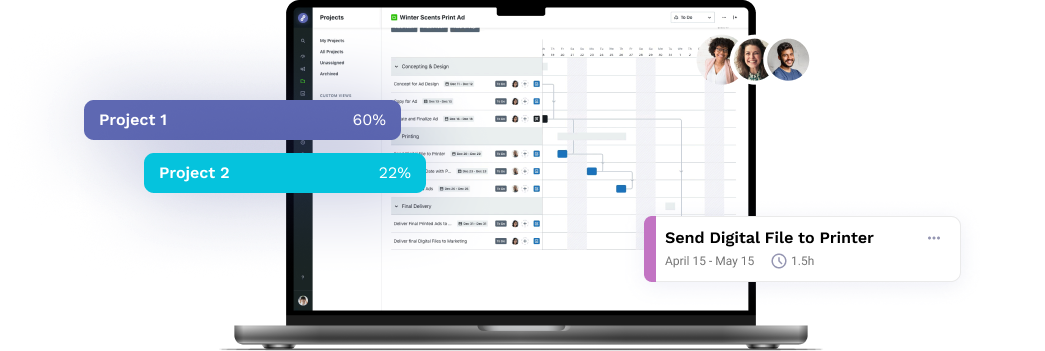Clearing the misconceptions about time tracking
Time tracking refers to how organizations record the working hours of hourly employees and ensure accurate compensation for their time.
There is a frequent misconception about time tracking that stems from its potential for strict enforcement. Often, team leads and supervisors fear its implementation feels like a form of micromanagement. Similarly, team members are concerned that the time data collected will be used against them.
While this perception is hard to break, given that it stems from a valid place, time tracking is not only meant to be used as a form of supervision. Neither is it only meant to track billable hours or build a case for an employee not having enough on their plate. Rather, it is a great tool teams should use to collect the data they need to assess efficiency, ensure strategic alignment, and reevaluate priorities. With sufficient data, you can reassign tasks and reallocate resources or make the case for outsourcing instead. Armed with it, a creative leader can also make a compelling case for a change to executive leadership. This will improve the team’s ability to create content that will have a significant impact.
How does time tracking software work?
Think of time tracking and level of effort as a chicken-or-the-egg type of situation. Meaning, you must pick one to start with and work your way from there to mature the other into a meaningful set of data. If you start with the level of effort, your first instance will be an educated guess – or a ‘guesstimate.’
Over time, you will become more accurate with predicting how long a project or task is likely to take your team to complete. Then, you should supplement that with the time tracking data and see how long the tasks really take.
Conversely, you may start with tracking time and use the data your creative team provides you with to inform your future project duration estimates. Either way, this is a winning recipe for every team that wishes to get honest and specific about their creative efforts.
Making the case for time tracking to your team
Before you can jump to making brilliant, data-backed decisions, how do you first get your creative team on board? Surely no employee, especially one in a creative field, will like time tracking software from the start. And with good reason – excessive restrictions often hinder creativity. The key here is for the supervisor to provide ample context about and be clear on the practice’s intent. You can do so by offering transparency on the whys behind tracking time and the improvements you expect to make. And this is how you get your team to understand and trust you and your decision.
Recently, the use of time tracking software to keep stakeholders aligned and informed has been gaining a lot of traction. And for good reason – when used correctly and systematically, it can bring huge improvements to your team and organization.
For successful internal and external buy-in, we suggest the following tips:
1. Gather data at the highest altitude possible
You can get as macro-level as you want while still collecting the necessary details for analytical insights. Try setting standard increments for time entries; minimum increment can be 15 minutes. Anything smaller is too granular to be meaningful and difficult to remember accurately. Set your maximum increments to 60 minutes – anything larger is unreasonable and difficult to calculate.
2. Develop and set expectations with your creatives
Discuss what data you are looking to collect with your team and ask for their ideas about how to get it. They will be far more likely to adapt and find success with decisions that they have a hand in making. Then, trust them to guide you on how they can get you the data in a way that is realistic and works with their processes. Everyone wins.
3. Build a ‘log time’ task into your project templates
Now that you have agreed on what data you will be gathering and how you will be gathering it, create automated reminders that will keep your creatives on top of inputting time in a timely fashion. And remember – recounting expended energy is easier to do as close to the event as possible.
Support your time tracking efforts with Lytho
Lytho Timesheets help you identify the gaps in your reporting by helping you gauge a task or project’s Level of Effort (projected time) and Time Tracked (actual time). Since creative projects have become quite ROI-driven, Timesheets helps show the man hours it takes to complete a project – allowing you to gauge whether it was worth the effort or not. It does so by offering a snapshot of availability for individuals, one employee at a time. With it, you can finally get rid of the boring and repetitive work by having the time-data to back up your request and need for outsourcing.
We at Lytho help you streamline your entire workflow and harmonize all brand collateral under a single, uniform platform. Feel free to reach out to us by scheduling a demo and learning how our creative solutions can boost the effectiveness of your creative projects. We look forward to speaking with you!
Do you want to give yourself and your creative team more room for creative stimulation by automating the boring stuff? Lytho helps you streamline your entire workflow and harmonize all brand collateral under a single, uniform platform. Feel free to reach out to us by scheduling a demo and learning how our creative solutions can boost the effectiveness of your creative projects. We look forward to speaking with you!

Ready to simplify your creative operations and start having a little fun at work again? Schedule time to talk with us.
Let us show you how Lytho’s Creative Operations Platform helps in-house creative and marketing teams do better work, ease the stakeholder experience, and stay on brand.
Schedule a Demo